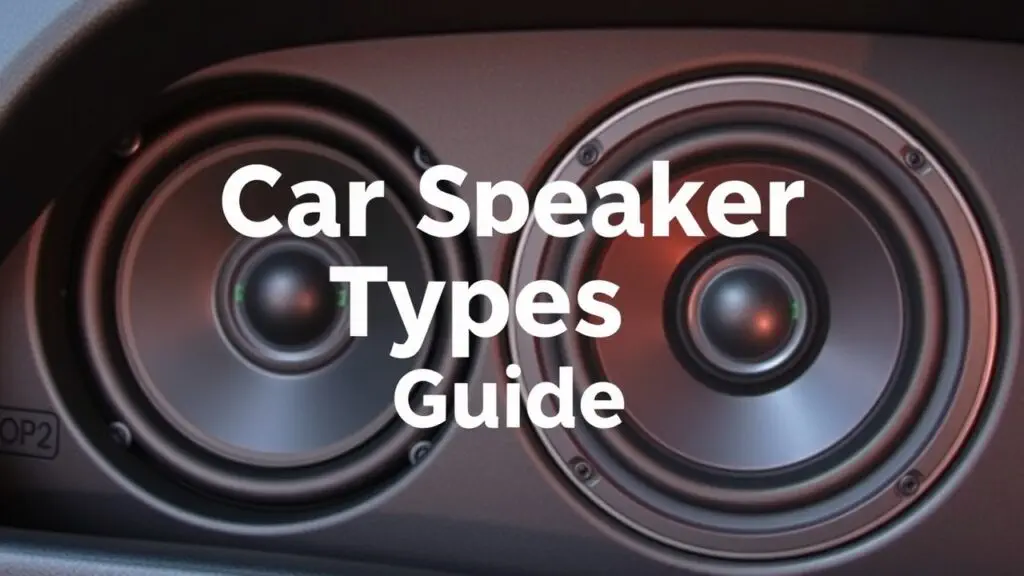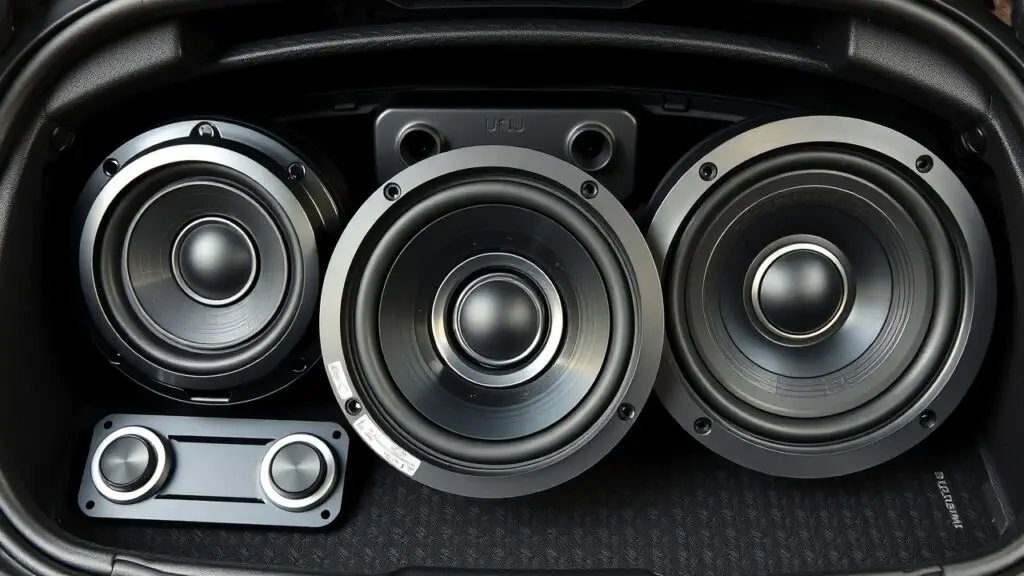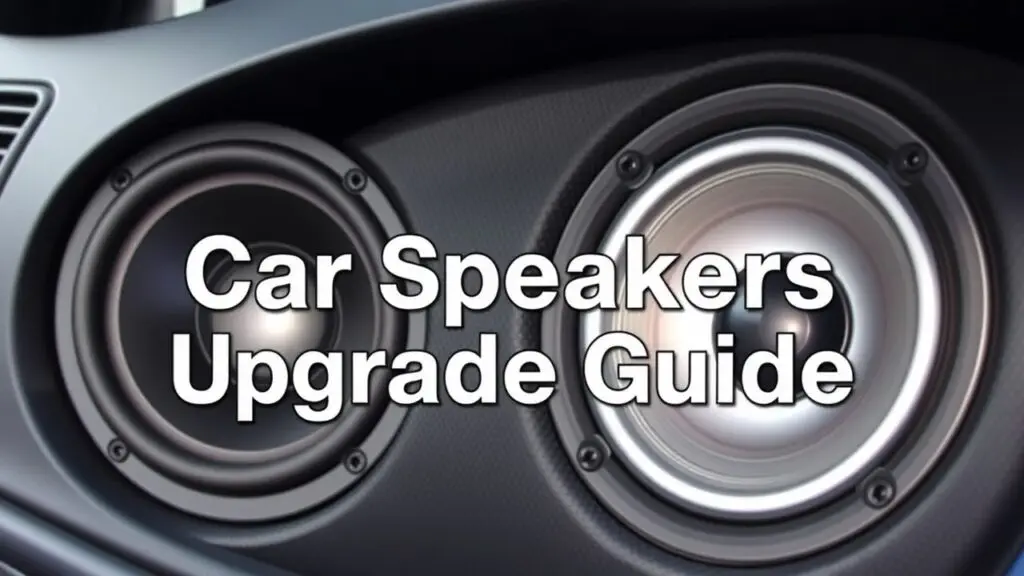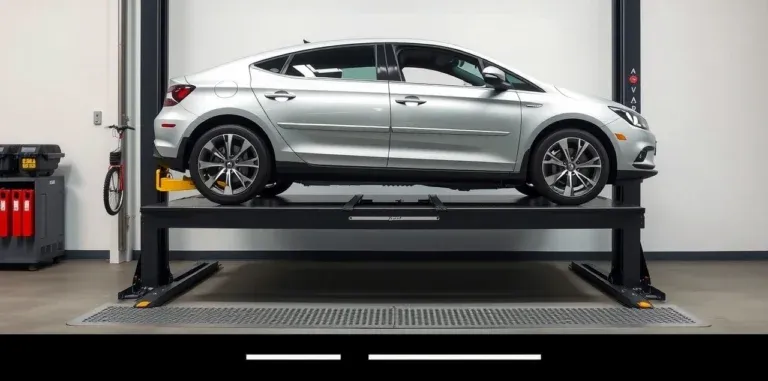Learn about different types of car speakers (coaxial, component, etc.) and find the best ones for your car and budget.
What Are Car Speakers and Why Do They Matter?

Car speakers are the parts of a vehicle’s audio system that change electrical signals into sound. They help you enjoy music, podcasts, and other audio while driving. The right car speakers can make a big difference in how good the sound is. Picking the right type helps improve your listening experience and ensures they work well with your car audio setup.
You can find different types of car speakers out there, each made for different needs and tastes. Knowing what options are available can help you choose speakers that fit well with your current car audio system. This choice also boosts sound quality. When you select the best speakers, you’ll get clearer voices, richer instrumentals, and a better overall experience.
When you’re looking at new car speakers, think about several important factors: speaker size, power handling, sensitivity ratings, and how hard they are to install. These factors help you find what fits your vehicle best and helps maximize performance.
Benefits of Upgrading Your Car Audio System
Upgrading your car audio system comes with some great benefits that make your listening time more enjoyable:
- Enhanced Sound Clarity: Newer speakers often provide clearer sound across all levels. You’ll notice crisp highs and deeper lows.
- Improved Bass Response: If you love genres like hip-hop or EDM, upgrading lets you feel the beat with strong low sounds.
- Customization Options: Many modern systems let you adjust the sound to match your style. Whether it’s balanced tones or bass-heavy vibes, you have choices!
Investing in good speakers not only makes your music sound better but also adds value to your car by creating a fun atmosphere during drives with friends or family.
Types of Car Speakers Explained
Coaxial vs Component vs Subwoofer – Which Is Right for You?
When you want to upgrade your car audio system, it’s good to know the different types of car speakers available. The main types are coaxial speakers, component speaker systems, and subwoofers. Each has its own features that fit different tastes and budgets.
Coaxial Speakers (Full-Range)
Coaxial speakers, often called full-range speakers, combine a woofer and a tweeter in one unit. This makes them compact and a great choice for those on a budget. You can easily upgrade your car’s sound without spending too much.
These speakers come in different setups, like 2-way or 3-way configurations. A 2-way speaker has a woofer for low sounds and a tweeter for high sounds. A 3-way speaker adds an extra driver for better midrange sounds.
| Pros | Cons |
|---|---|
| Affordable price | Limited customization options |
| Easy installation | May not give the best sound staging |
| Compact design | Less powerful than component systems |
Coaxial speakers offer good value if you’re looking to boost your vehicle’s audio experience without spending a fortune.
Component Speaker Systems
Component speaker systems have separate woofers, tweeters, and sometimes midrange drivers. This design helps you place each driver where it can perform best inside your car.
Using component systems brings several benefits:
- Better sound clarity across all frequency ranges.
- More control over tuning options.
- Great for music lovers who want improved sound quality.
These setups are ideal if you’re serious about getting the best audio quality from your car’s sound system.
Subwoofers
Subwoofers focus on low-frequency sounds or bass notes. Regular car speakers may struggle with these lower tones. Subwoofers add depth to genres like hip-hop and electronic music by delivering powerful bass that makes listening more enjoyable.
There are different types of subwoofers:
- Sealed Subwoofer: Gives tight bass but needs more power.
- Ported Subwoofer: Offers louder output at lower frequencies but can lack precision.
- Bandpass Subwoofer: Combines both sealed and ported designs; great for specific uses but may not be versatile.
When choosing between powered or passive subwoofers:
- Powered subwoofers come with built-in amplifiers, making them easier to install.
- Passive subwoofers need external amplifiers, allowing more customization but requiring extra components in your setup.
Think about the size limits in your vehicle when picking a subwoofer, along with how you want to connect it to your existing audio system.
Understanding these types of car speakers will help you make smart choices for improving your vehicle’s audio experience based on what you like and what fits your budget!
Understanding Coaxial Speaker Configurations
Coaxial speakers are widely used in car audio systems. They are popular because they save space while providing full-range sound. These speakers combine multiple types into one unit, making them a smart choice for enhancing your vehicle’s audio experience. There are different configurations like 2-way, 3-way, and even 4-way systems.
2-way Systems
A 2-way coaxial speaker system includes a woofer and a tweeter in the same enclosure. The woofer handles low frequencies, while the tweeter takes care of high frequencies. This setup is perfect for anyone wanting an affordable upgrade with decent sound quality without needing much space.
3-way Systems
3-way coaxial speakers add a midrange driver along with the woofer and tweeter. This extra driver allows sounds to be separated better across different frequencies, which means improved overall sound quality. You’ll notice clearer vocals and instruments, making these systems great for anyone who enjoys music a lot.
4-way Systems
If you’re looking for high performance, 4-way coaxial speakers include all three previous components plus another tweeter or specialized drivers for specific frequency bands. These systems can give you top-notch sound quality but usually come at a higher price.
Advantages and Disadvantages of Each Configuration
Here’s a simple table showing the pros and cons of each type:
| Configuration | Advantages | Disadvantages |
|---|---|---|
| 2-Way | Affordable; compact; good sound | Limited range; less bass |
| 3-Way | Better quality; clearer sounds | More expensive; harder to install |
| 4-Way | Excellent performance; great detail | High cost; complex installation |
When comparing budget car speakers to premium options from brands like Kicker or Rockford Fosgate, think about these factors based on your sound preferences and budget.
Factors to Consider When Choosing a Coaxial System
Choosing the right coaxial speaker takes some thought:
- Vehicle Compatibility: Check out vehicle-specific speaker kits to ensure a good fit.
- Universal-Fit Options: If you’re unsure about compatibility or might move them later.
- Installation Skills: Decide if you’ll install them yourself or need help from professionals since some setups require skill.
Keeping these factors in mind can help you choose wisely when upgrading your car audio system.
Unleashing the Potential of Component Systems

Component speaker systems are built for great sound. They give you better audio than other types of car speakers. A component system has separate parts: woofers, tweeters, and midrange speakers. Each part does its job to create high-quality sound.
Detailed Explanation of Separate Components
Woofer: The woofer handles low frequencies, usually from 20 Hz to about 2 kHz. It gives you rich bass sounds that make music more enjoyable.
Tweeter: Tweeters take care of high frequencies, typically above 2 kHz up to 20 kHz or more. They produce clear treble sounds, which are crucial for hearing vocals and instruments clearly.
Midrange Speakers: Midrange speakers fill in the space between woofers and tweeters. They cover frequencies from around 500 Hz to 4 kHz. This range includes many vocal tones and instrumental details that make music clear and vibrant.
Advantages of Component Systems Over Coaxial Systems
Component systems have some clear benefits compared to coaxial (full-range) speaker systems:
- Sound Quality: With separate parts for different frequency ranges, component systems deliver improved sound clarity and depth.
- Staging: You can place each speaker separately. This allows for better imaging and staging inside your vehicle. It creates a more immersive listening experience.
These features make component speakers a top choice for audiophiles who want high-quality car audio solutions.
Importance of Crossovers
Crossovers are key in any component system because they direct specific frequency ranges to the right speakers (woofers or tweeters). There are two main types:
- Passive Crossovers: These use passive electronic parts like capacitors and inductors without needing extra power. They filter signals based on set crossover points.
- Active Crossovers: Active crossovers need power because they actively manage signal distribution before it gets to the amplifiers or speakers.
Using crossovers ensures that each driver works within its best frequency range. This improves overall performance.
Choosing the Right Component System for Your Needs and Budget
When picking a component speaker system, think about your budget and sound quality needs:
- If you’re watching your spending but still want decent audio, budget car speakers can be a good option.
- For those ready to spend more on their audio setup, high-end car speakers often provide better materials and acoustic capabilities.
Looking at these factors helps you find a balance between cost and great sound that fits your preferences.
Choosing and Installing the Right Subwoofer
Upgrading your car audio system is a big deal, and picking the right subwoofer is key for that rich bass sound. A good subwoofer can change how you experience music by making low sounds come to life, which regular speakers might struggle with.
Different Types of Subwoofers
There are three main types of subwoofers you should know about: sealed, ported, and bandpass. Each has its own perks and quirks:
- Sealed Subwoofers: These boxes are airtight. They give you tight, accurate bass but need more power to get really loud.
- Ported Subwoofers: These have a vent or hole that lets air escape. This design boosts efficiency and volume at low frequencies, which means louder bass, but it can be less precise than sealed models.
- Bandpass Subwoofers: This type mixes sealed and ported designs in one box. They let certain frequencies through while blocking others. They can pump out powerful bass but might lack clarity in the sound.
Knowing these types helps you figure out what suits your music taste best.
Factors to Consider When Choosing a Subwoofer
When choosing a subwoofer, keep these factors in mind:
- Size: The size matters! Bigger woofers usually create deeper bass.
- Power Handling: Look at the watts RMS (Root Mean Square). This tells you how much power it can handle without going fuzzy or breaking.
- Enclosure Type: Deciding between sealed or ported will affect how it sounds; think about what kind of music you listen to.
- Frequency Response: A wider range is better. Aim for lower limits around 20 Hz so you can feel those deep notes.
These points help you pick a subwoofer that fits your needs perfectly.
Subwoofer Placement and Installation Considerations
Where you place your subwoofer matters for getting the best sound:
- Putting it near corners can boost low-frequency sounds since they bounce off walls.
- Make sure there’s space around it for airflow; if it’s too cramped, it might overheat or sound muffled.
When installing, double-check connections so there’s no rattling noise while driving.
Powered vs. Passive Subwoofers – Understanding the Differences
Powered subwoofers come with their own amplifiers, making them easier to set up since they don’t need extra gear. They’re convenient but might not offer as many options for tuning.
Passive subwoofers rely on an external amplifier, giving you more control over power levels but making the installation a bit trickier due to extra wiring needed.
Both types have good points based on how much control you want over your sound settings.
Making the Right Choice for Your Needs and Budget
When you’re ready to boost your car’s sound, picking the right speakers is super important. There are different types of car speakers out there, and knowing what each offers helps you find the best ones for you. Whether you want high-quality sound or just need budget car speakers, understanding key features can really enhance your listening time.
Key Factors to Consider
Before you start looking at specific models, think about these important factors:
- Vehicle Type: The size and shape of your vehicle matter a lot when choosing speakers. Compact cars have less space compared to larger vehicles like SUVs or trucks.
- Listening Preferences: Consider what music styles you love most. If you’re into bass-heavy music like hip-hop or EDM, getting a subwoofer could be a good idea.
- Existing Audio System: Look at your current setup. Do you need full replacements or just upgrades to what you have?
- Installation Skills: Some speaker systems can be tricky to install. Decide if you’ll need professional help or if you can tackle it yourself.
Determining the Correct Speaker Size
Finding the right speaker size is key for fitting them in your vehicle:
Popular sizes include:
- 6×8 Car Speakers
- 6×9 Car Speakers
- 5×7 Car Speakers
To get the right fit, remove your old speakers and measure them carefully before buying new ones.
Understanding Speaker Specifications
Knowing the basics about speaker specifications will help you make smart choices:
- RMS Power: This shows how much continuous power a speaker can handle without distortion.
- Peak Power Handling: This is the maximum power level a speaker can manage in short bursts.
- Sensitivity Rating: A higher sensitivity means louder sound with less power needed.
- Impedance: Most car audio systems work best with 4-ohm or 2-ohm ratings; make sure they match your amplifier.
Step-by-Step Guide to Choosing Car Speakers
Follow these simple steps when picking new car speakers:
- Set a budget based on what you can afford.
- Research different models and brands within that budget.
- Measure your existing speakers or check fitment guides to ensure they will fit.
- Look over technical specifications like frequency response and power ratings before making a final choice.
By keeping these points in mind, you’ll find it easier to choose from various types of car speakers that fit your needs and budget perfectly.
Installation and Care for Optimal Performance

Importance of Proper Installation
Proper installation is key for getting the most out of your car audio system. If you install speakers right, they sound clearer and better overall. Bad installation can cause rattling or distortion. This messes up your listening fun. Plus, when speakers are set up well, they last longer. This is because good mounting and wiring reduce stress on parts that might get damaged otherwise.
DIY vs. Professional Installation
When picking between DIY car audio installation or hiring experts, think about what each choice offers.
DIY Car Audio Installation:
- Pros: It’s cheaper; you learn more about your system; you can work on your own schedule.
- Cons: You need tools and knowledge; mistakes can hurt sound quality.
Professional Car Speaker Installation:
- Pros: Experts make sure everything works great; saves time; often includes warranties.
- Cons: Costs more than doing it yourself.
Think about how comfortable you feel with tools and electronics against your budget when making this choice.
Tools and Materials Needed for Installation
To install new speakers in your ride, you’ll need the right tools and materials:
Essential Tools:
- Screwdrivers (flathead & Phillips)
- Wire strippers
- Socket wrench set
- Pliers
Materials:
- Speaker wiring harness
- Connectors (like butt connectors)
- Mounting brackets
Having these ready will make the whole installation easier.
Basic Speaker Installation Steps
Putting in coaxial or component speakers involves some simple steps:
- Take out old speakers carefully with screwdrivers.
- Disconnect old wires while remembering how they connect.
- Prepare new speakers by attaching any needed adapters or mounts.
- Connect speaker wires by color—usually red (+) to positive terminals and black (-) to negative terminals.
- Securely attach new speakers using screws from kits.
- Test the sound before putting everything back together, just in case adjustments are needed.
Following these steps makes sure everything works well whether you’re using full-range coaxial models or more detailed component systems meant for better sound.
Car Speaker Maintenance Tips
Keeping your car’s audio system in good shape is important for lasting performance:
- Regularly dust off speaker grilles with a soft cloth or vacuum attachment made for delicate surfaces.
- Keep speakers dry to avoid damaging parts inside—try parking under cover during rainstorms if possible.
- Check connections from time to time to ensure no rust has formed at wire junctions since this can affect sound clarity.
By sticking to these maintenance tips, you’ll keep your car’s audio system sounding great for years!
Sound Dampening: Why and How?
Sound dampening means using special materials inside a car to cut down on unwanted noise while boosting overall sound quality. It helps enhance the listening experience by reducing vibrations when driving.
Benefits include:
- Less vibration from rough roads,
- Better bass from subwoofers,
- A clearer sound without outside distractions!
Using items like mass-loaded vinyl sheets placed around doors or the trunk cuts down interference so listeners can enjoy their music without outside noise ruining it!
Car Speaker FAQs
What are the types of car audio speakers?
The main types of car audio speakers are coaxial, component, and full-range speakers. Each type serves different needs and sound preferences.
How do I choose the right car speaker size?
To choose the right speaker size, measure your existing speakers or refer to your vehicle’s specifications. Common sizes include 6.5″, 6×9″, and 5.25″.
Do I need an amplifier for my car speakers?
An amplifier is not always necessary. Powered speakers come with built-in amplifiers, while passive systems require external amplification for optimal performance.
What is a crossover in car audio systems?
A crossover directs specific frequencies to the appropriate drivers in a speaker system. It ensures that woofers handle low frequencies and tweeters handle high frequencies.
How do speaker materials affect sound quality?
Speaker materials like polypropylene cones, silk dome tweeters, and PEI tweeters influence sound clarity and durability. High-quality materials often result in better audio performance.
What are shallow mount car speakers?
Shallow mount speakers are designed for vehicles with limited depth space. They offer a good fit without compromising sound quality.
How do I improve my car’s audio quality?
You can improve audio quality by upgrading to high-performance speakers, adding a subwoofer for bass, or installing sound dampening materials to reduce noise interference.
What are the benefits of using aftermarket car speakers?
Aftermarket speakers provide enhanced sound quality compared to OEM options. They often offer better frequency response, increased power handling, and improved overall audio experience.
Additional Insights on Car Speakers
- Speaker Types: Explore various speaker types like coaxial car speakers, component systems, and subwoofers.
- Car Speaker Sizes: Familiarize yourself with sizes such as 4×6, 5.25, 6.5, and 8-inch options.
- Speaker Installation: Consider installation kits for seamless upgrades or repairs.
- Sensitivity Ratings: Pay attention to speaker sensitivity ratings to determine efficiency.
- Wattage Matters: Understand RMS power handling and peak power limits for optimal performance.
- Diverse Brands: Brands like Kicker, Rockford Fosgate, JL Audio, and Focal lead in quality options.
- Tuning Options: Investigate audio tuning methods to personalize your listening experience.
- Speaker Enclosures: Select proper enclosures for subwoofers to enhance sound delivery.
- High-Fidelity Audio: Seek high-fidelity audio solutions for an immersive experience.
- Sound Dampening Solutions: Use sound dampening materials to improve acoustic performance inside your vehicle.
These insights will help you navigate through various aspects of upgrading your car audio system effectively!
Related Topics
- types of subwoofers
- types of coaxial speakers
- types of tweeters
- types of car audio systems
- types of speaker enclosures
- types of subwoofer enclosures
- types of crossovers (car audio)
- types of speaker installations (DIY vs. professional)



Types of Car Speakers: A Complete Guide